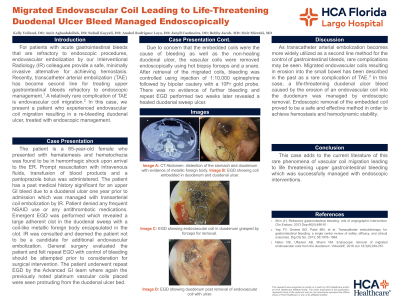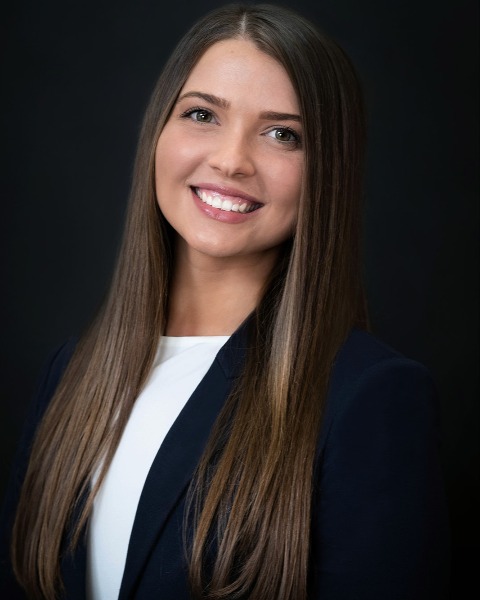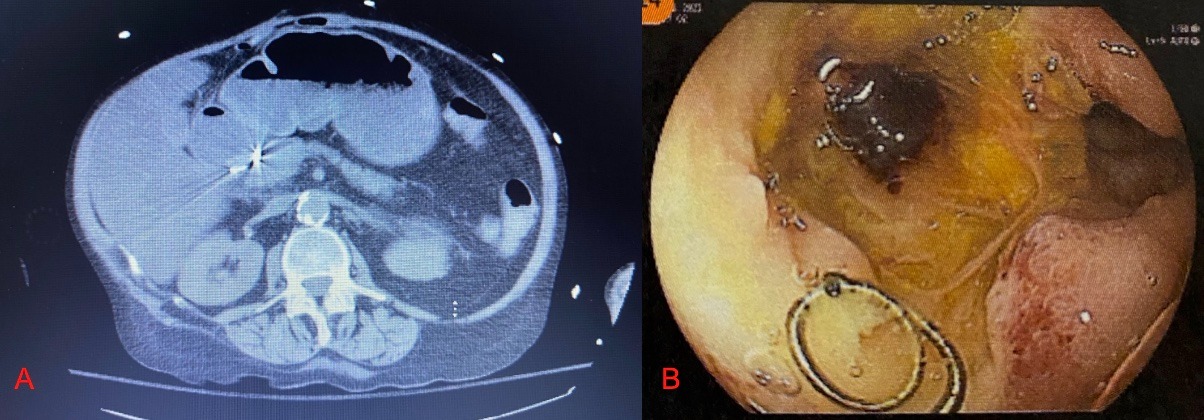Sunday Poster Session
Category: Interventional Endoscopy
P0894 - Migrated Endovascular Coil Leading to Life-Threatening Duodenal Ulcer Bleed Managed Endoscopically
Sunday, October 22, 2023
3:30 PM - 7:00 PM PT
Location: Exhibit Hall

Has Audio

Kelly Volland, DO
HCA Healthcare/USF Morsani College of Medicine: HCA Florida Largo Hospital
Largo, FL
Presenting Author(s)
Kelly Volland, DO1, Amir Aghaabdollah, DO1, Suhail Kayyali, DO1, Anabel Rodriguez Loya, DO2, Janyll Castineira, DO1, Bobby Jacob, MD2, Meir Mizrahi, MD2
1HCA Healthcare/USF Morsani College of Medicine: HCA Florida Largo Hospital, Largo, FL; 2HCA Florida Largo Hospital, Largo, FL
Introduction:
For patients with acute gastrointestinal bleeds that are refractory to endoscopic procedures, endovascular embolization by our Interventional Radiology (IR) colleagues provide a safe, minimally invasive alternative for achieving hemostasis. A rare complication of this method is endovascular coil migration. In this case we present a patient who experienced endovascular coil migration resulting in a re-bleeding duodenal ulcer, treated with endoscopic management.
Case Description/Methods:
The patient is a 65-year-old female who presented with frank hematemesis with hematochezia found to be in hemorrhagic shock upon arrival to the ER. Prompt resuscitation with intravenous fluids, transfusion of blood products and pantoprazole bolus was administered. The patient has a past medical history significant for an upper GI bleed due to a duodenal ulcer one year prior to admission which was managed with transarterial coil embolization by Interventional Radiology (IR). Patient denied any frequent NSAID use or any antithrombotic medications. Emergent EGD was performed which revealed a large adherent clot in the duodenal sweep with coil-like metallic foreign body encapsulated in the clot. IR consultation deemed the patient not to be a candidate for further additional endovascular embolization and General surgery felt repeat EGD with control of bleeding should be attempted prior to consideration of surgical intervention. Patient underwent repeat EGD by the Interventional GI team where again the previously noted platinum vascular coils placed were seen protruding from the duodenal ulcer bed. Due to concern that the migrated vascular coils was the cause of bleeding as well as the non-healing duodenal ulcer, the vascular coils were removed endoscopically using hot biopsy forceps and a snare. After retrieval of the migrated coils we then performed control of bleeding using injection of 1:10,000 epinephrine followed by bipolar cautery using 10Fr gold probe. There was no evidence of further bleeding and repeat EGD performed 2 weeks later revealed a healed duodenal sweep ulcer.
Discussion:
This case adds to the current literature of this rare phenomena of vascular coil migration leading to a life threatening GI bleeding which was successfully managed with endoscopic interventions.

Disclosures:
Kelly Volland, DO1, Amir Aghaabdollah, DO1, Suhail Kayyali, DO1, Anabel Rodriguez Loya, DO2, Janyll Castineira, DO1, Bobby Jacob, MD2, Meir Mizrahi, MD2. P0894 - Migrated Endovascular Coil Leading to Life-Threatening Duodenal Ulcer Bleed Managed Endoscopically, ACG 2023 Annual Scientific Meeting Abstracts. Vancouver, BC, Canada: American College of Gastroenterology.
1HCA Healthcare/USF Morsani College of Medicine: HCA Florida Largo Hospital, Largo, FL; 2HCA Florida Largo Hospital, Largo, FL
Introduction:
For patients with acute gastrointestinal bleeds that are refractory to endoscopic procedures, endovascular embolization by our Interventional Radiology (IR) colleagues provide a safe, minimally invasive alternative for achieving hemostasis. A rare complication of this method is endovascular coil migration. In this case we present a patient who experienced endovascular coil migration resulting in a re-bleeding duodenal ulcer, treated with endoscopic management.
Case Description/Methods:
The patient is a 65-year-old female who presented with frank hematemesis with hematochezia found to be in hemorrhagic shock upon arrival to the ER. Prompt resuscitation with intravenous fluids, transfusion of blood products and pantoprazole bolus was administered. The patient has a past medical history significant for an upper GI bleed due to a duodenal ulcer one year prior to admission which was managed with transarterial coil embolization by Interventional Radiology (IR). Patient denied any frequent NSAID use or any antithrombotic medications. Emergent EGD was performed which revealed a large adherent clot in the duodenal sweep with coil-like metallic foreign body encapsulated in the clot. IR consultation deemed the patient not to be a candidate for further additional endovascular embolization and General surgery felt repeat EGD with control of bleeding should be attempted prior to consideration of surgical intervention. Patient underwent repeat EGD by the Interventional GI team where again the previously noted platinum vascular coils placed were seen protruding from the duodenal ulcer bed. Due to concern that the migrated vascular coils was the cause of bleeding as well as the non-healing duodenal ulcer, the vascular coils were removed endoscopically using hot biopsy forceps and a snare. After retrieval of the migrated coils we then performed control of bleeding using injection of 1:10,000 epinephrine followed by bipolar cautery using 10Fr gold probe. There was no evidence of further bleeding and repeat EGD performed 2 weeks later revealed a healed duodenal sweep ulcer.
Discussion:
This case adds to the current literature of this rare phenomena of vascular coil migration leading to a life threatening GI bleeding which was successfully managed with endoscopic interventions.

Figure: Figure: A. CT Abdomen: Distention of the stomach and duodenum with evidence of metallic foreign body. B. EGD showing coil embedded in duodenum and duodenal ulcer.
Disclosures:
Kelly Volland indicated no relevant financial relationships.
Amir Aghaabdollah indicated no relevant financial relationships.
Suhail Kayyali indicated no relevant financial relationships.
Anabel Rodriguez Loya indicated no relevant financial relationships.
Janyll Castineira indicated no relevant financial relationships.
Bobby Jacob indicated no relevant financial relationships.
Meir Mizrahi indicated no relevant financial relationships.
Kelly Volland, DO1, Amir Aghaabdollah, DO1, Suhail Kayyali, DO1, Anabel Rodriguez Loya, DO2, Janyll Castineira, DO1, Bobby Jacob, MD2, Meir Mizrahi, MD2. P0894 - Migrated Endovascular Coil Leading to Life-Threatening Duodenal Ulcer Bleed Managed Endoscopically, ACG 2023 Annual Scientific Meeting Abstracts. Vancouver, BC, Canada: American College of Gastroenterology.
